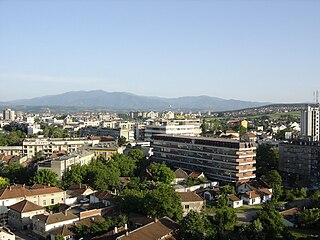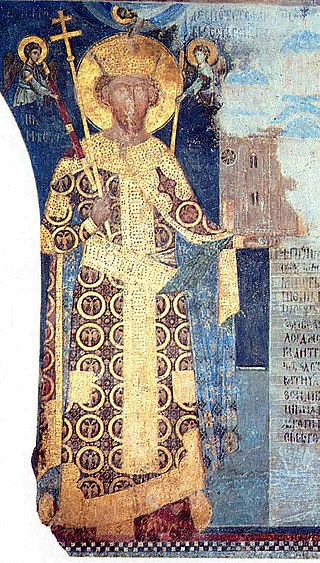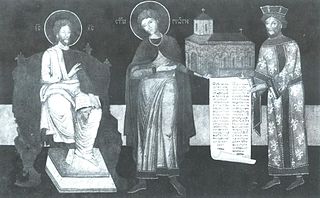
Kruševac is a city and the administrative center of the Rasina District in central Serbia. It is located in the valley of West Morava, on Rasina river. According to the 2022 census, the city administrative area has a population of 113,582 while the urban area has 68,119 inhabitants.

The Pomoravlje District is one of eight administrative districts of Šumadija and Western Serbia. It expands to the central parts of Serbia. According to the 2011 census results, it has a population of 214,536 inhabitants. The administrative center is the city of Jagodina.

The Rasina District is one of eight administrative districts of Šumadija and Western Serbia. It expands to the central parts of Serbia. According to the 2011 census results, it has a population of 241,999 inhabitants. The administrative center of the Rasina District is Kruševac.

Stefan Lazarević, also known as Stefan the Tall, was a Serbian ruler as prince (1389–1402) and despot (1402–1427). He was also a diplomat, legislator, ktetor, patron of the arts, poet and one of the founding members of the Order of the Dragon. The son of Prince Lazar Hrebeljanović, he was regarded as one of the finest knights and military leaders of his time. After the death of his father at Kosovo (1389), he became ruler of Moravian Serbia and ruled with his mother Milica, until he reached adulthood in 1393. Stefan led troops in several battles as an Ottoman vassal, until asserting independence after receiving the title of despot from the Byzantines in 1402.

The Manasija Monastery also known as Resava, is a Serbian Orthodox monastery near Despotovac, Serbia founded by Despot Stefan Lazarević between 1406 and 1418. The church is dedicated to the Holy Trinity. It is one of the most significant monuments of medieval Serbian culture and it belongs to the "Morava school". The monastery is surrounded by massive walls and towers. Following its foundation, the monastery became the cultural centre of the Serbian Despotate. Its School of Resava was well known for its manuscripts and translations throughout the 15th and 16th centuries. Manasija complex was declared Monument of Culture of Exceptional Importance in 1979, and it is protected by Republic of Serbia, and the monastery entered the UNESCO Tentative List Process in 2010.

The Ljubostinja Monastery is a Serbian Orthodox monastery near Trstenik, Serbia. Located in the small mountain valley of the Ljubostinja river, the monastery is dedicated to the Holy Virgin.

Trstenik is a town and municipality located in the Rasina District of central Serbia. As of 2022 census, the town has 13,476, while the municipality has 35,875 inhabitants. It lies on the West Morava river.

Ćićevac is a town and municipality located in the Rasina District of central Serbia. According to 2022 census, the population of the town is 3,902, while the population of the municipality is 7,860.

The Rasina is a river in south central Serbia. The 92 km (57 mi) long river flows through the Serbian Rasina region, gives its name to the modern Rasina District of Serbia, and flows into the Zapadna Morava near the city of Kruševac.
Morava architectural school, also known as the Morava style, or simply as the Morava school, is an ecclesiastical architectural style that flourished in the Serbian Late Middle Ages, during the reign of the Lazarević and Branković dynasties.

The architecture of Serbia has a long, rich and diverse history. Some of the major European style from Roman to Postmodern are demonstrated, including renowned examples of Raška, Serbo-Byzantine with its revival, Morava, Baroque, Classical and Modern architecture, with prime examples in Brutalism and Streamline Moderne.

Naupara monastery is a Serbian Orthodox Christian monastery situated 30 km south of the town of Kruševac and about 190 km from Belgrade. The original building was completed in 1391 but was severely destroyed by Turks in 1454. It was not restored until 1835 when brothers Stojan Simić and Aleksa Simić took on the project. They offered the church a bell, sacred books, and other religious items upon its completion. Naupara is built in the Serbian architectural style of the Morava school and was constructed in the same style as the Lazarica Church. The paintings and iconostasis within the monastery date to the 19th century since the original frescos were ruined during the restoration. Today, Naupara is an active nunnery, with a small number of nuns who tend to the land.

The Monastery of the Holy Archangels is a Serbian Orthodox monastery located in Prizren, Kosovo. The monastery was founded by the Serbian Emperor Stefan Dušan between 1343 and 1352 on the site of an earlier church, part of the Višegrad fortress complex. It was the burial church for Emperor Dušan, and represented the culmination of the Serbian ecclesiastical architectural style, that led to the birth of the Morava school style.

Koznik Castle is a medieval castle in central Serbia, 10 km northwest from the town of Aleksandrovac, on a hillside of Kopaonik, on the right bank in the upper flow of the Rasina river. The castle was built on top of a steep hill dominating the surrounding terrain at 920 m altitude.

The Koporin Monastery is a monastery at the outskirts of the town of Velika Plana, Serbia, just off the road to Smederevska Palanka. The monastery church, dedicated to St. Stephen, was built during the reign of Despot Stefan Lazarević (1389–1427) whose portrait is preserved as a fresco inside the church, under the inscription "Despot". Stefan Lazarević acquired this title after the Battle of Ankara in 1402, and on that basis the painting was dated. The ktetor and the exact time of the monastery's founding is unknown. Stefan Lazarević is buried in this church. The monastery was in a dilapidated state until the 1880s, when reconstruction began. In the late 1950s and 1960s, massive conservation of architectural elements and paintings was finished.

Radič also known as Radich Postupovich was a Serbian nobleman that had the title of Grand Čelnik, the highest dignitary after the Serbian monarch. He began his service under Prince, later Despot, Stefan Lazarević as čelnik, then was elevated to Grand Čelnik during the rule of Despot Đurađ Branković. He was very wealthy, and held the silver mines in Novo Brdo of the Serbian Despotate. Radič founded and renovated several churches and monasteries which still exist, including the notable Vraćevšnica and Kastamonitou. He took monastic vows and became a monk in Kastamonitou where he spent his last years.

Kurvingrad or Koprijan (Копријан), is a ruined fortress which sits above the town of Doljevac on the South Morava river, 11 km south of the town of Niš. The ruins are all that remain of the medieval town of Koprijan from the time of Classical antiquity; the fortress is over a thousand years old. Today, fortifications remain, but have not been substantially studied.

The Lepenac Monastery is a monastery of the Eparchy of the Kruševac of Serbian Orthodox Church from the 15th century. The monastery is located on the right bank of the river Rasina near the village of Lepenac, Serbia, and is only 700 meters away from the main Brus-Kruševac road. The monastery is dedicated to Saint Stephen and is one of the largest and most beautiful monasteries of the Morava architectural school and of that time in general.

The Rudenica Monastery is a monastery located near the village of Rudenica, Serbia, that belongs to the Eparchy of Kruševac of the Serbian Orthodox Church.

The Drenča or Dušmanica Monastery is located near the place of the same name, not far from Aleksandrovac and belongs to the Eparchy of the Kruševac of Serbian Orthodox Church.




























